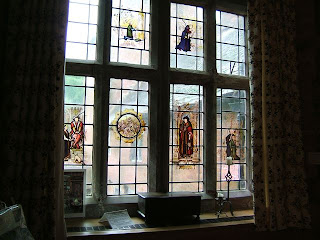It is open to the public. The visitors fee is £5. You can go around on your own or join a tour led by a volunteer. It is well worth joining a tour. Mine was very interesting and informative.
As you can see from the photograph it is a very attractive building with its red brick and sandstone.
Nicholas Owen, who was the leading builder of priest holes, must have spent a long time at Harvington Hall.
Whoever built them displayed a sound knowledge of practical psychology. For example, this one was underneath a corridor. If the trapdoor had been put in a room there would have been the danger that someone sitting in the room might might notice some anomaly and investigated, but nobody lingers in a corridor.
The piece of wood on the left just looks like a supporting timber.
However, it tilts up to reveal a priest hole. This hole was so well hidden that it was only discovered in the 20th century by some children who were playing.
My favourite was this one. The priest hole is in the ceiling of a room and to get to it you have to climb up this chimney.
It would have been interesting to see more on the history of the house and how it was restored. There could also have been more on Elizabeth's persecution of the Catholics that created the need for the priest holes.
Harvington Hall is well worth a visit.
Other moated manor houses
See my posts on Ightham Mote and Baddesley Clinton [Baddesley Clinton is about 20 miles to the east of Harvington Hall. The house is under the care of the National Trust.]









Hi I am a guide at the Hall - those are not transfers! (agree that really would be naff) They were once part of a church window stained glass.
ReplyDeleteThey depict the life of Thomas More who was executed by Henry VIII for his beliefs.
I love old treasures like this!!
ReplyDelete